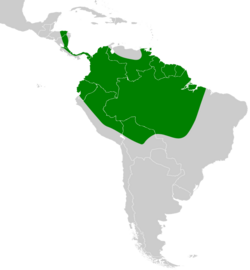Biology:White-flanked antwren
| White-flanked antwren | |
|---|---|

| |
| Male in Acre, Brazil File:Myrmotherula axillaris - White-flanked Antwren XC248418.mp3 | |
| Scientific classification | |
| Domain: | Eukaryota |
| Kingdom: | Animalia |
| Phylum: | Chordata |
| Class: | Aves |
| Order: | Passeriformes |
| Family: | Thamnophilidae |
| Genus: | Myrmotherula |
| Species: | M. axillaris
|
| Binomial name | |
| Myrmotherula axillaris (Vieillot, 1817)
| |

| |
The white-flanked antwren (Myrmotherula axillaris) is an insectivorous bird in the antbird family, Thamnophilidae.
Taxonomy
The white-flanked antwren was described by the French ornithologist Louis Pierre Vieillot in 1817 and given the binomial name Myrmothera axillaris.[2] The silvery-flanked antwren (Myrmotherula luctuosa) was previously treated as conspecific.
Description
The white-flanked antwren is typically 10.7 cm (4.2 in) long, and weighs 8.1 g (0.29 oz). The adult male has dark grey upperparts, black underparts, and black wings with bars of white spots. The flanks and underwings are white. The female and immature male have brown upperparts, yellowish-buff underparts and weakly barred rufous wings. Her flanks and underwings are white, much like the male.
Males of the distinctive western race M. a. melaena have black upperparts and underparts, and the female is darker than nominate M. a. axillaris.
Distribution and habitat
The white-flanked antwren is a resident breeder in tropical Central and South America from El Salvador and Honduras south to Amazonian Bolivia and southern Brazil , and on Trinidad. The white-flanked antwren is found throughout the entire Amazon Basin as well as to the southeast in the adjacent Tocantins-Araguaia River drainage, and then in disjunct groups on the southeast coast of Brazil; it also ranges through the Guyanas on the northeast of South America to Pacific and Caribbean coastal regions of Ecuador, Colombia, and Venezuela; also, the entire eastern Venezuela Orinoco River grouping is part of the northern Amazon range. The northern Andes cordillera bifurcates the Central American and coastal groups of the northwest from the Amazonian range.
Behaviour
This is a common and confiding bird of primary and second growth forest, usually found in small groups. The female lays two purple-marked white eggs, which are incubated by both sexes for 16 days to hatching, in a small plant fibre and dead leaf cup nest low in a tree or shrub.
The white-flanked antwren feeds on small insects and other arthropods taken from twigs and foliage in the lower branches of trees. It has a queep whistle followed by a trilled trrrrrr. M. a. melaena has a two note call, naa-who and a whistled descending pee pee pee-pee-pee-pee-pee-puu-puu call. Given the differences in plumage and vocalisations, the two forms may possibly be different species.
References
- ↑ BirdLife International (2016). "Myrmotherula axillaris". IUCN Red List of Threatened Species 2016: e.T103657467A93832394. doi:10.2305/IUCN.UK.2016-3.RLTS.T103657467A93832394.en. https://www.iucnredlist.org/species/103657467/93832394. Retrieved 19 November 2021.
- ↑ Vieillot, Louis Pierre (1817) (in French). Nouveau dictionnaire d'histoire naturelle, appliquée aux arts, à l'agriculture, à l'économie rurale et domestique, à la médecine, etc.. 12. Paris: Deterville. p. 113. https://biodiversitylibrary.org/page/18057863.
Further reading
- Skutch, Alexander F. (1969). "White-flanked antwren". Life Histories of Central American Birds III: Families Cotingidae, Pipridae, Formicariidae, Furnariidae, Dendrocolaptidae, and Picidae. Pacific Coast Avifauna, Number 35. Berkeley, California: Cooper Ornithological Society. pp. 214–218. https://sora.unm.edu/sites/default/files/journals/pca/pca_035.pdf#page=214.
External links
- White-flanked antwren videos on the Internet Bird Collection
- Stamps[Usurped!] (for Nicaragua) with RangeMap
- White-flanked antwren photo gallery VIREO
- White-flanked antwren Photo; Article www.ib.usp.br
Wikidata ☰ Q636532 entry
 |


